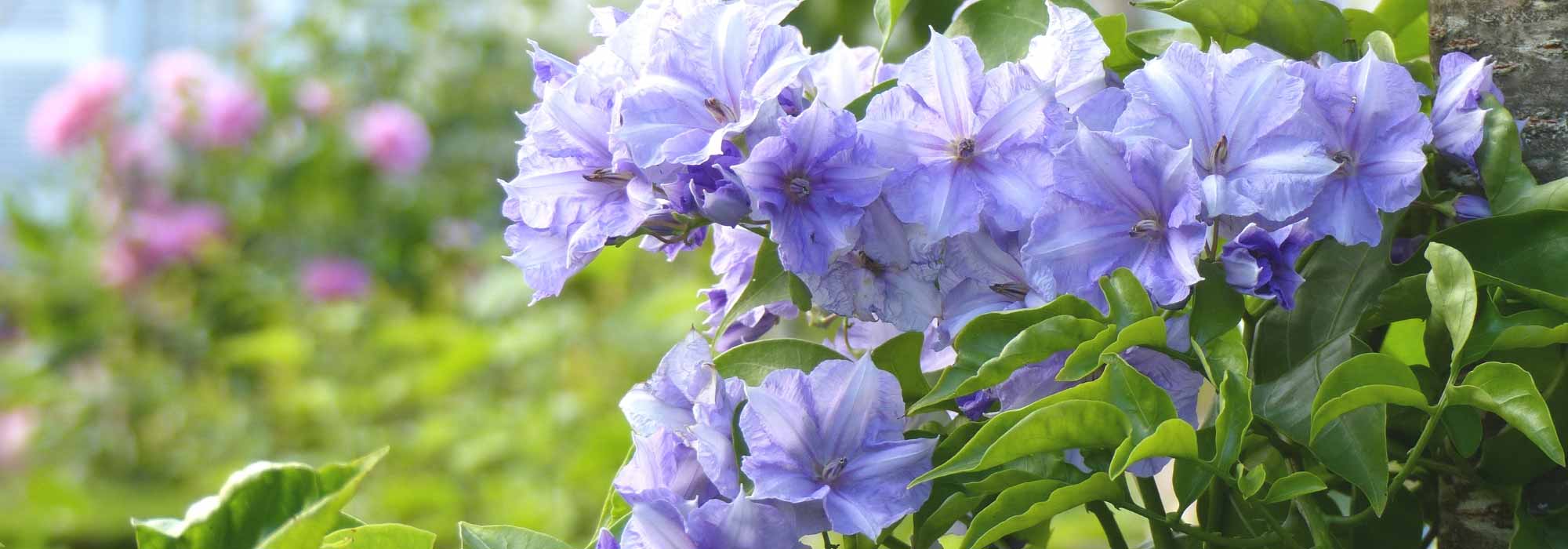
Solanum, potato vine: planting, pruning, growing
Contents
Solanum in a nutshell
- Solanum is a graceful climbing plant, very floriferous, of rapid growth and really easy to grow in mild climate
- With elegant foliage and pale, star-shaped flowering, this liana blooms tirelessly from spring until frosts on any support provided
- At end of flowering, very decorative red or yellow-orange fruits appear on some solanums, such as “Pommier d’amour”
- In-ground cultivation is only possible in southern gardens, but it adapts well to pot culture and can be overwintered under cover elsewhere
- Perfect for dressing a sunny wall, trellis or fence
A word from our expert
Solanum is a graceful climbing plant prized for its rapid growth and for its tireless pastel flowering from June until the first frosts.
Sadly not very hardy, it is an exotic, luxuriant plant best suited to southern and seaside gardens, whose mild climate it favours.
Elsewhere, it can be grown without difficulty in a large pot and overwintered indoors in a greenhouse or conservatory.
From Solanum jasminoides (syn. Solanum laxum) or “false-jasmine nightshade” to Solanum crispum, via Solanum rantonetii or “tree gentian” and Solanum pseudocapsicum or “Jerusalem cherry”, with its fruits resembling cherry tomatoes, they all charm either by their flowering or by their spectacular fruiting.
While most solanums climb any available support — a wire fence, a trellis or a wall — and are studded with small star-shaped flowers in pale blue, gentian blue or white, others, more sarmentous than truly climbing, such as Solanum rantonetii, can be trained as a standard or even as bonsai.
Solanum in a pot for conservatory or terrace or Solanum to grow in open ground, let yourself be seduced by their delicate flowering and choose the Solanum you need in our collection!
And be tempted by our Mediterranean climbing plants!
Description and botany
Botanical data
- Latin name Solanum
- Family Solanaceae
- Common name Potato tree, potato vine
- Flowering May to November
- Height 2 to 6 m
- Exposure full sun or partial shade
- Soil type All, well drained
- Hardiness -5°C to 10°C
The Solanum is a sarmentous climbing plant belonging to the large botanical family Solanaceae, just like potato (Solanum tuberosum), tomato and the poisonous belladonna and Datura.
It originates from warm, humid areas of South America, notably Brazil and Chile. The genus Solanum comprises about 1,400 herbaceous, shrubby and arborescent species, including Solanum jasminoides, recently renamed Solanum laxum but more commonly called “false jasmine”, Solanum crispum, another luxuriant liana, and Solanum rantonetii, commonly called “gentian tree” or “tree gentian” because of the intense colour of its blue-violet flowers: very floriferous, it is widely cultivated.
They have produced interesting cultivars with white or ultramarine-blue flowers.
Impossible to forget Solanum pseudocapsicum, better known as “Jerusalem cherry” or “Christmas cherry” with its round, fleshy fruits shaped like small tomatoes in orange, yellow or red.
All are tender and are grown in ground only in regions free from frost. They are classic plants of Mediterranean gardens. In more continental regions, they are easily grown in a large pot and brought indoors for winter.
With a very rapid growth, this sarmentous climber, once established, produces long flexible, almost voluble shoots that clamber over any support. Size varies according to Solanum species.
Solanum jasminoides and Solanum crispum can reach adult size, on average 5 to 6 m high and almost as wide, within one or two seasons. If left unrestrained, they will develop as groundcover.
Solanum rantonetii forms a bushy shrub with often trailing branches and shows less vigorous growth: it will not exceed 2 m in height and will present a very ramified silhouette at maturity.

Some Solanums: S. jasminoides ‘Album’, S. crispum, S. pseudocapsicum and S. rantonetii
Solanum pseudocapsicum forms a small, rounded, very ramified shrub not exceeding 45 cm in height. With its miniature tree habit, it is so often grown indoors that it is nicknamed “house solanum”.
The more or less flexible, trailing branches carry an elegant, luxuriant foliage reminiscent of jasmine. The foliage is evergreen to semi-persistent in mild climates but can be deciduous if exposed to frost. The leaves, arranged alternately along stems, are oblong to lanceolate, or strongly pinnate, sometimes divided into 3 or 5 lobes or bearing lobed leaflets, often with undulate margins. Measuring from 2 to 25 cm depending on species, they are glossy or downy.
Coloured bright to dark green, they sometimes redden in cold. Some cultivars bear sumptuous cream-variegated foliage.
This lush growth forms an elegant setting for the flowers. Solanum is valued for its flowers and decorative fruits.
Plant is covered with a multitude of small flowers that renew continuously from May until first frosts. Flowering can sometimes last up to eight months in frost-free regions. The five-petaled flowers are bell-shaped, trumpet-open or more often small star-shaped, typical of Solanaceae (hence nickname “Star of Bethlehem”).
They measure 1 to 6 cm across and open in numerous small clusters, sometimes umbelliform or paniculate, 2 to 15 cm wide, in leaf axils or at branch tips.
Often characterised by a gentian-like bluish-violet, some cultivars produce a very bright light blue or a pure white enhanced by a cluster of prominent yellow-orange stamens.
Slightly scented, the flowers give off a faint jasmine fragrance. After flowering, they develop into fruits, small toxic berries if ingested, round or ovoid, purple, red, vermilion, orange or yellow, 1 to 2 cm in diameter. This decorative fruiting is, however, rare under our climates.
Fortunately, Solanum pseudocapsicum, mostly grown as a seasonal houseplant, allows enjoyment of these fruits through autumn and much of winter when this shrub is kept warm or grown outdoors in mild climates. Dotting the plant like small cherry tomatoes or tiny oranges, first green, they turn yellow, then orange and finally bright red when ripe. They inspired common names such as Jerusalem cherry and “christmas orange”.
Like jasmine, Solanum is quite tender, rarely tolerating temperatures below -5 °C/-8 °C. It is easy to grow in ground in very mild winter regions. It is a classic of Mediterranean gardens but can adapt as far as the Paris region in very sheltered situations. Elsewhere, in cold climates, it should be grown exclusively in pots and overwintered frost-free, similar to an orangerie plant.
It needs heat and sun and a fertile, cool but very well drained soil.
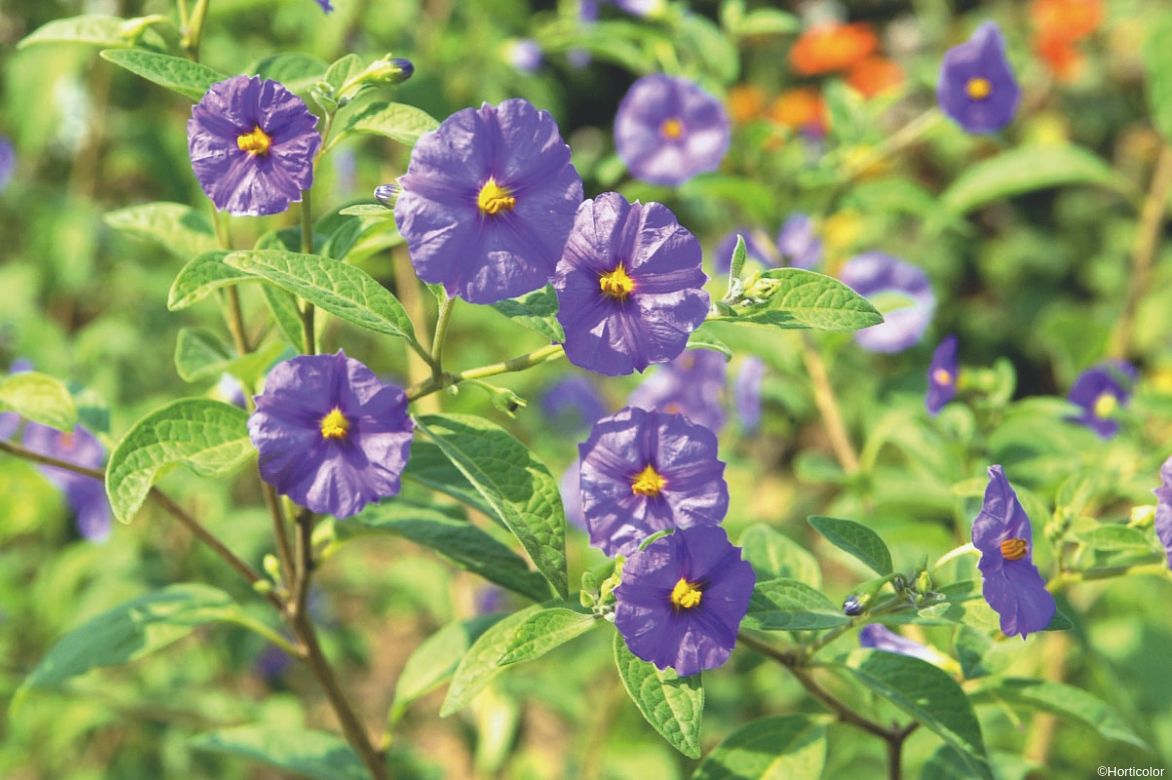
Solanum rantonetii with sumptuous intense blue-violet flowers
This sarmentous liana readily scrambles against a wall, trellis or pergola. Untrained, left free, it can also form a magnificent, somewhat tangled groundcover.
Its delicate flowering brings much charm and elegance to garden or terrace.
Main species and varieties
There are over 1,400 species of Solanum, among them the classic Solanum jasminoides with star-shaped white, blue or violet flowers and Solanum crispum, the hardiest of Solanums, which are two vigorous but frost-tender lianas. Solanum rantonnetii, “the gentian tree” is a more shrubby species with astonishing gentian-blue flowers!
They have all spawned sumptuous cultivars that have enriched the palette of blues, from pastel blue to the most intense ultramarine blue.
A must for collectors in the garden or year-round in a conservatory!
Most popular
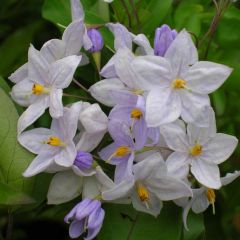
Solanum jasminoides Blue
- Flowering time July to November
- Height at maturity 5 m
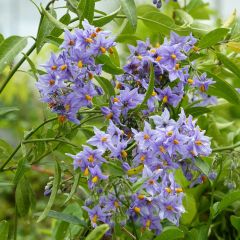
Solanum crispum Glasnevin
- Flowering time July to November
- Height at maturity 5 m
Our favourites

Solanum jasminoides Blue
- Flowering time July to November
- Height at maturity 5 m

Solanum jasminoides Album
- Flowering time July to November
- Height at maturity 5 m
Discover other Solanum
View all →Available in 0 sizes
Available in 1 sizes
Available in 1 sizes
Available in 1 sizes
Available in 1 sizes
Available in 1 sizes
Planting
Where to plant Solanum?
From its tropical and subtropical origins, Solanum has retained a marked sensitivity to cold. Not very hardy, it does not tolerate severe frost. Easy to grow in open ground in Mediterranean or coastal areas, elsewhere its hardiness will be severely tested.
Foliage is killed by cold from 0°C–2°C, while its stump withstands only weakly down to -5°C. Some are hardier than they appear, sometimes resisting down to -8 to -10°C in well-sheltered situations under a thick protective mulch, the stump re-sprouting in spring without difficulty.
In regions with harsh winters, north of the Loire, grow Solanum in a large container kept sheltered on a terrace and brought indoors for winter, protected from frost.
It needs warmth and sun: give it a very sunny position, sheltered from draughts. It prefers partial shade in hot climates rather than blazing sun that scorches its flowers.
It is tolerant of summer drought once established and can cope with ordinary, even slightly calcareous, soil provided it is always perfectly drained. It nevertheless prefers fertile, deep soils in which it can truly thrive.
Solanum can be used in countless ways in a mild climate garden to flower an arbour, clothe a tree, adorn a well-exposed wall, a pergola, a trellis, a wire fence… How wonderful when it provides welcome shade after covering a pergola! Its foliage remains semi-evergreen in mild climate: a considerable asset when wishing to mask an unattractive wall or façade. Untrained, it forms an elegant groundcover.
This woody climbing stem liana needs an airy spot because its growth is rapid from first year after planting.
Some Solanum such as Solanum rantonnetii can even be trained as standards or grown as bonsai.
The Solanum will also form a lovely floriferous shrub in a large pot sheltered on balcony or terrace, to be brought inside away from frost in cold regions. For “Love apples” grown indoors, place near a window but not in blazing sun.
When to plant Solanum?
Planting Solanum is done in spring from March to May after last frosts because this plant is frost-tender. Meanwhile, you can pre-cultivate it in a pot in a warm, bright room to speed growth. Planting in September–October is possible in mild climate.
How to plant Solanum?
Given rapid, vigorous growth of Solanum, 1 plant per m² is sufficient as it can spread 3–6 m in just two or three seasons. Dig 20 cm from wall or chosen support.
- Soak rootball in bucket of water before planting
- Dig hole two to three times wider than rootball
- Lay a bed of gravel or clay balls to improve drainage
- Mix some well-rotted compost into excavated soil
- Position plant, base of stems level with soil surface
- Refill hole
- Firm down lightly
- Water abundantly
- Mulch base to keep cool in summer
- Tie branches onto support
How to plant Solanum in a pot?
Substrate must be very free-draining to avoid stagnant moisture around roots of Solanum.
- In a large terracotta pot, place a good drainage layer (gravel or clay balls) to fill ¼ of pot height
- Plant Solanum in a compost for Mediterranean plants or for geraniums, or simply in a mix of turf, sand, leaf mould and garden soil
- Tie stems onto support
- Water
- Store pot for winter away from cold but in light, in a conservatory or cool greenhouse
→ Learn more about growing Solanum in a pot in our growing guide!
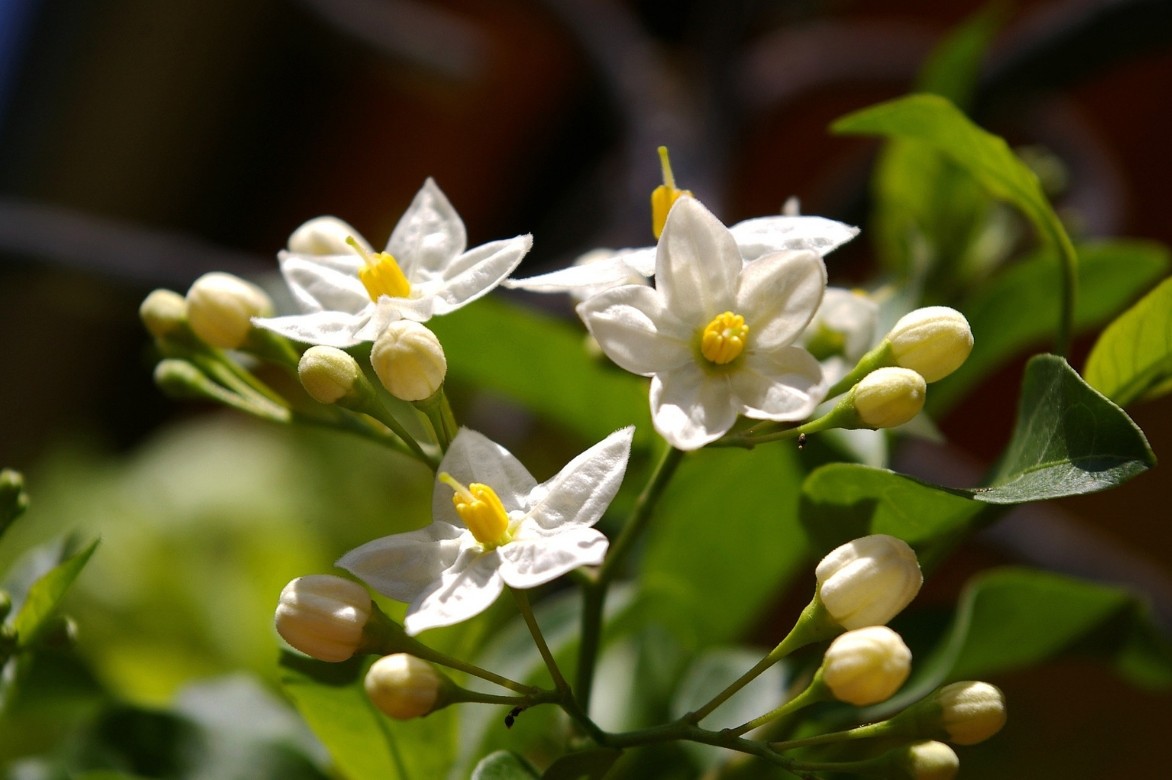
Maintenance, pruning and care
Solanum requires little care once well established. Sun and regular watering are the secrets to ensuring good development.
In open ground
Water regularly and generously during first year after planting to support establishment. Afterwards, it will tolerate drought well and will only require occasional waterings in summer to support flowering.
Solanum is fairly demanding and needs fertile soil to improve its flowering. It benefits from regular feeding during growth, especially in poor soil. A top-dressing of compost worked in by light cultivation in spring and summer will encourage and prolong flowering.
Tie in new shoots as they develop. Remove faded flowers regularly; this will encourage renewal of flowering.
In mild regions, if severe cold is forecast, protect above-ground parts of the plant with a fleece for winter protection and mulch the stump from October with dead leaves. More info in our advice sheet “How to protect Mediterranean plants from cold and frost in winter”.
In regions with harsh winters, bring potted solanums indoors before first frosts, keeping them protected from cold in a very bright frost-free room.
In pots
The solanum grown in a pot must be watered more regularly. Water regularly without allowing the rootball to dry out when it is hot. During growth water once to twice a week and apply a liquid feed twice a month. Reduce watering in winter to every 15 days and stop all feeding.
Spray foliage often with soft water if you want to keep your potted solanum indoors year-round, as foliage and flowers wilt quickly when air is too dry.
Top-dress each year in spring with compost and repot every 3 years in spring, and every year for Solanum pseudocapsicum.
Bring pots indoors as soon as temperatures fall below 2/3°C and overwinter them protected from winter frosts in a greenhouse or lightly heated conservatory where temperature will not drop below 10°C. You can put them back out in spring, when temperatures have warmed and frosts are definitely over.
→ Find out more in our advice sheet How to overwinter a Solanum?
At the start, help stems climb their support and tie them in as they develop.
When and how to prune a Solanum?
No pruning is really essential, but it can be useful to contain its growth!
With Solanum jasminoides and crispum, pruning simply involves controlling their spread, removing weak or damaged shoots and balancing the branches to restore a nice rounded habit.
Solanum tends to be invasive but tolerates pruning well, even severe pruning, and does not mind being cut back every year.
- Prune every year in spring, early March.
- Cut back stems to three to four buds (about 30 cm from soil) and remove old shoots and broken stems.
- You can also tidy the liana throughout the season without problem to control bulk or encourage branching.
Pruning of Jerusalem cherry is not necessary every year given its limited growth. Pinch out young stems in spring to encourage branching and cut stems back by half every three years if you have managed to keep this species that long, as very dry indoor air often proves fatal after a year.
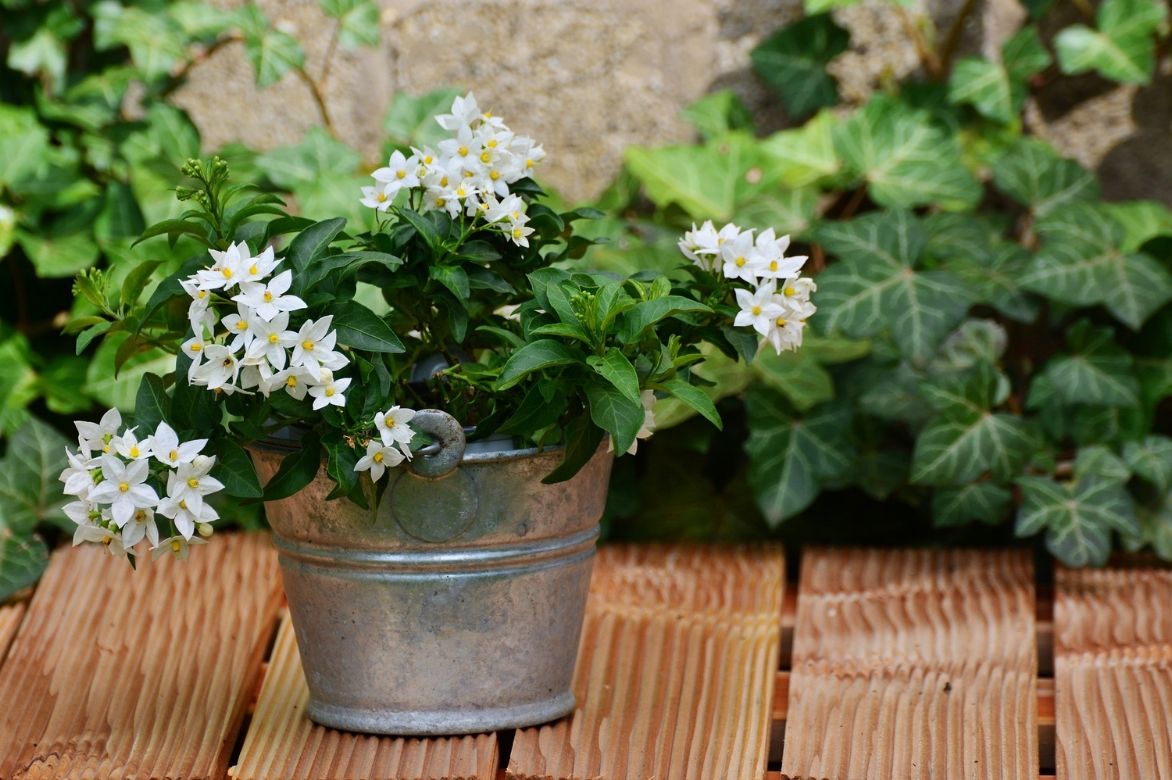
Training a Solanum as a standard
Solanum rantonnetii or « Arbre aux gentianes » can easily be trained into a small standard shrub by pruning the lower branches.
→ Find out more in our tutorial: How to prune a climbing Solanum or a standard Solanum?
How to train Solanum?
Stems of Solanum do not have tendrils, which is why it is necessary to train them by tying them in as soon as they are planted in open ground or in a pot. Supports are varied: Solanum can lean against a wall, cascade over a low stone wall, wrap around a tree, climb a wire fence or a trellis.
On a smooth wall: fix eye bolts and stretch nylon lines horizontally every 50 cm to guide the stems.
Potential diseases and pests
Solanum has no enemies; only plants grown indoors may be more vulnerable to red spider mite infestations, common when the plant lacks water and the environment is too dry and confined. To eliminate them, spray with a nettle maceration.
Presence of aphids is sometimes visible on leaves. Spray with soapy water.
Propagation
Solanum is easily propagated by herbaceous stem cuttings between April and June. Layering is also possible, although more tedious.
How to propagate solanum by cuttings?
Solanum cuttings will flower from following summer.
- Using pruning shear, take cuttings 5 to 8 cm long, flexible, green and free of flowers
- Remove lower leaves
- Push cuttings into buckets filled with potting compost, turf and sand
- Firm down and water
- Regularly moisten substrate with a spray bottle
- Place pot in partial shade under cover, frost-free in winter at a temperature between 10 and 15 °C in greenhouse or conservatory
- Plant out in ground or repot each cutting individually the following spring
By layering
Layering of solanum carried out at end of autumn yields rooted layers about one year later.
- Dig a long trench 15 cm deep and 1 m to 2 m long depending on length of chosen shoot
- Bend this long low stem down towards soil
- Remove lower leaves
- Score bark for about 3 to 5 cm on parts to be buried, at level of a node
- Bury one or several sections to a depth of 15 cm to encourage rooting
- Secure layers in soil with metal pegs driven into ground
- Cover with potting compost, firm down and water
- Thereafter, water when soil is dry
- One year later, the following autumn, separate layers from parent plant; they will be sufficiently rooted: cut stems where they enter the soil
- Replant layers in ground at final position or in pots
Associating
Slender and possessing rare elegance, Solanum thrives in gardens of varied styles, lending them charm and poetry. It is a staple of blue or white romantic gardens. Above all, it is a classic of Mediterranean and exotic gardens, where it brings much freshness in summer.
While Solanum does well alone on a trellis or fence, it is often found in fresh, romantic pairings with climbing roses and other beautiful climbing plants such as clematis, honeysuckle, Jasmine, passionflower, a trumpet vine (Campsis radicans) or Podranea ricasoliana.
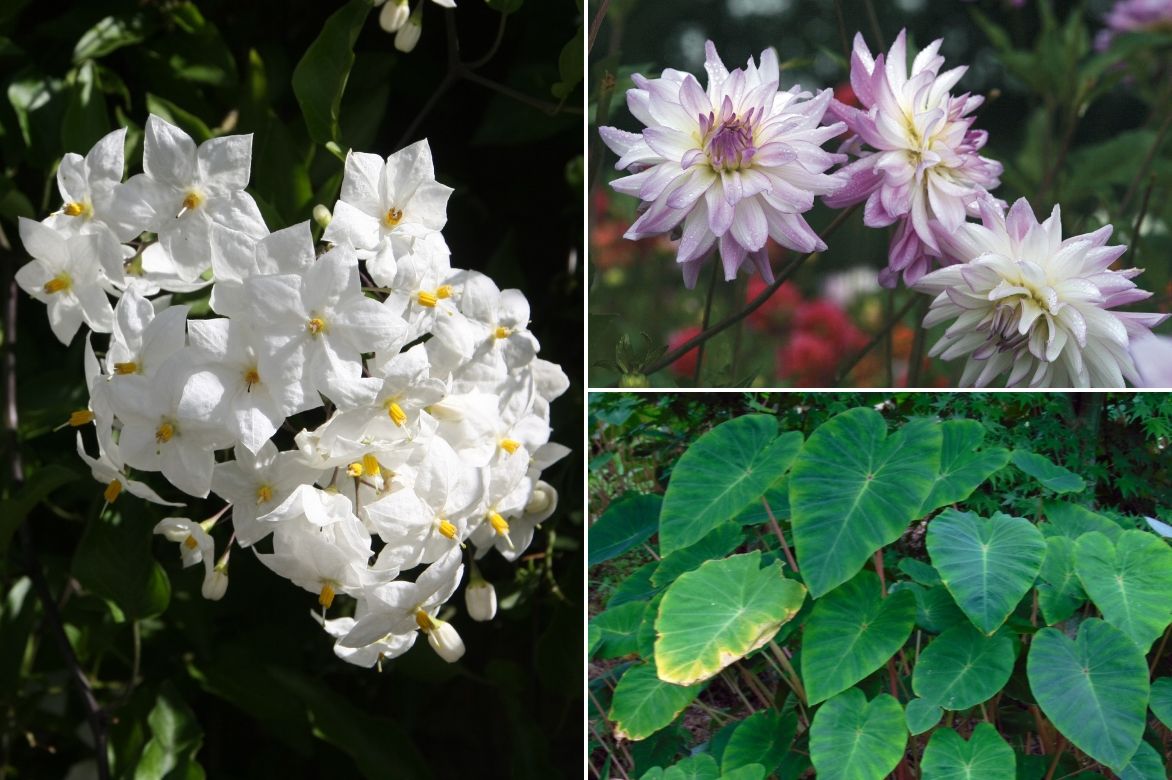
An exotic pairing idea: Solanum jasminoides ‘Album’ (or ‘Bleu’) on a structure with a few Dahlia ‘Victoria Ann’ planted in front, accompanied by Colocasia ‘Madeira’
In a Mediterranean garden, for a more exotic touch, pair it with a Mediterranean climber such as bougainvillea or Plumbago capensis (Cape plumbago).
In our mildest regions, train it against a wall in open ground at the foot of Mexican orange, abutilon or tree mallow.
In a pot kept warm over winter, it pairs perfectly with Convolvulus mauritanicus or Ampelaster carolinianus, a climbing aster that flowers in late autumn.
→ Discover more ideas for pairing Solanum
Useful resources
- Our collection of Mediterranean climbers features top species and varieties, discover them!
- How will your potted plants fare during your absence? Here are our tips!
- Fancy a climber? Discover all our tips are on our blog to train, to grow and care for them
- Got a wall in the garden? Get inspiration from our ideas to dress it up!
- Discover our 7 ideas for pairing Solanum!
- Our article: Grow Solanum in a pot
- Learn more about overwintering Solanum
- Discover 8 climbing plants with blue flowers every garden should have
- Our tutorial: How to prune a climbing or standard Solanum?
- Subscribe!
- Contents
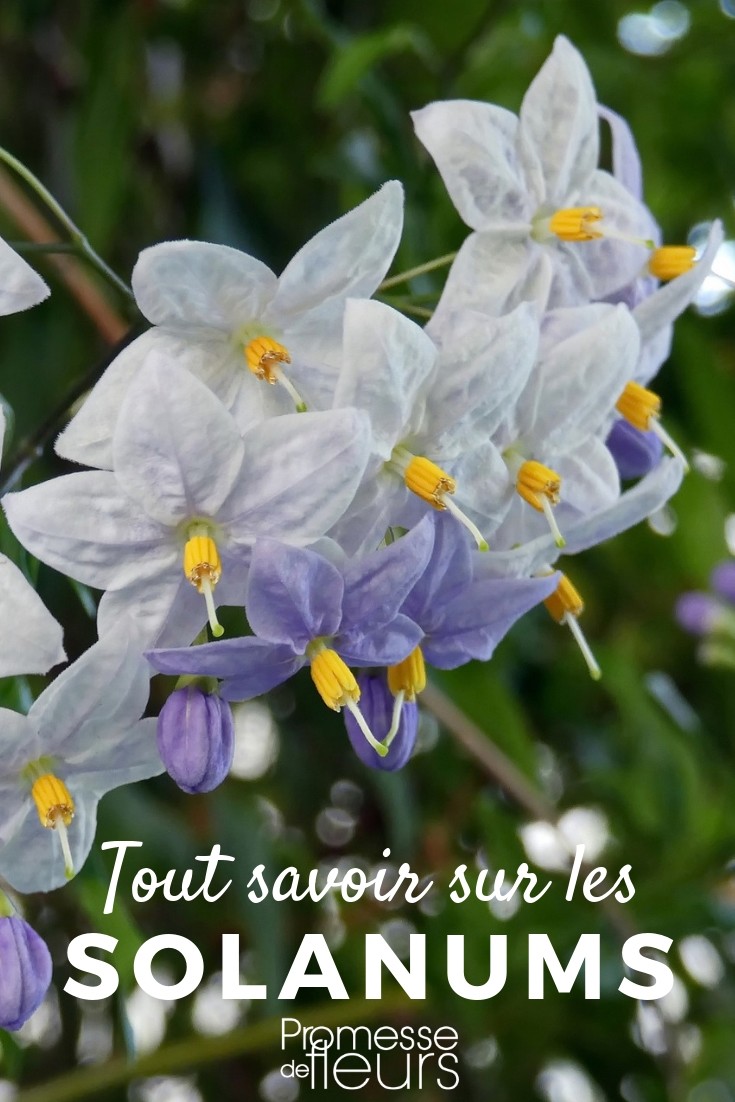































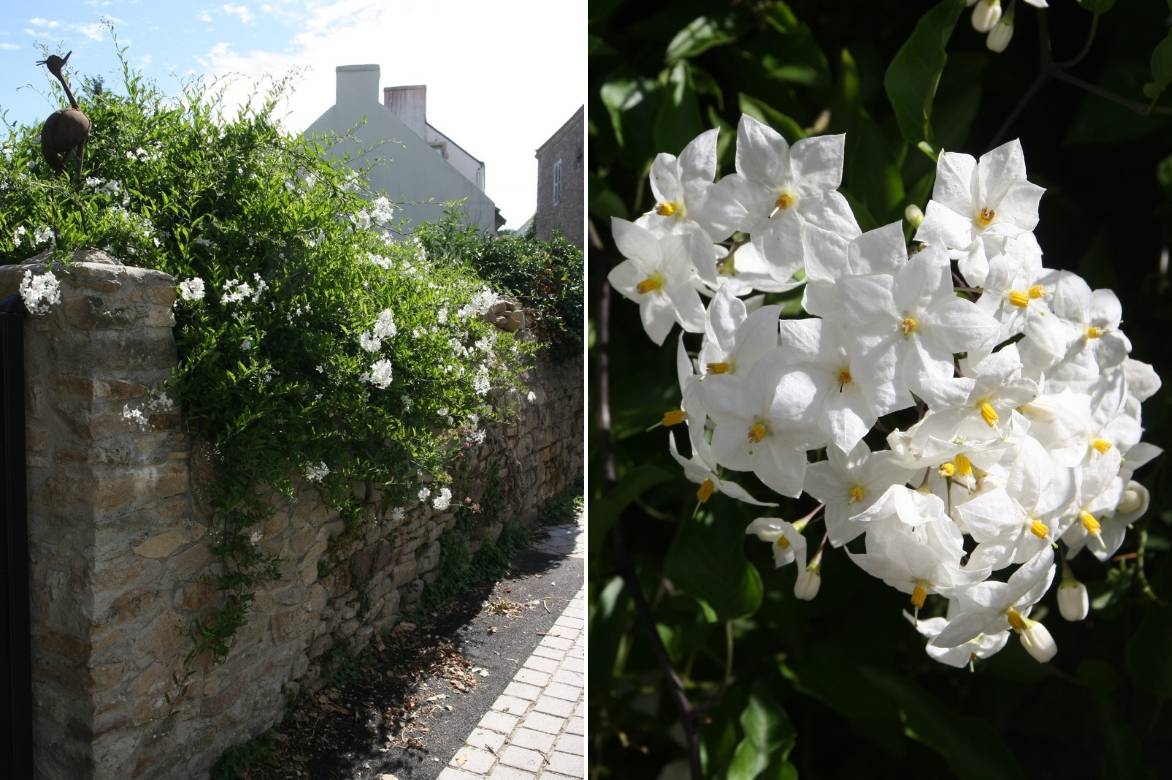
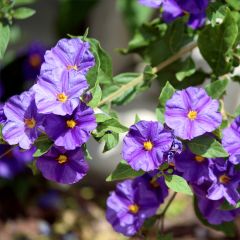
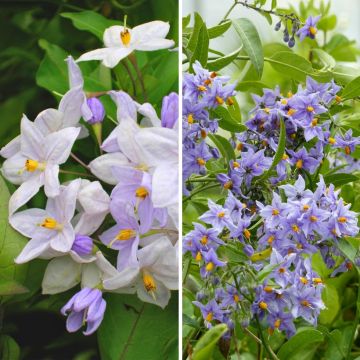




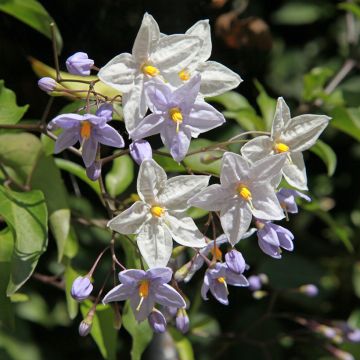
Comments